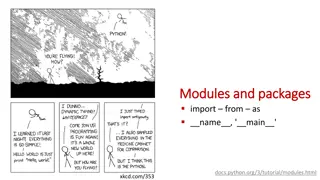
Introduction to If-Else Conditional Statements and Syntax
This chapter introduces the basic usage of if-else statements and the syntax for implementing if, elif, and else statements in Python programming. Understand the structure, indentation rules, and examples of using if-else blocks for decision-making scenarios.
Download Presentation

Please find below an Image/Link to download the presentation.
The content on the website is provided AS IS for your information and personal use only. It may not be sold, licensed, or shared on other websites without obtaining consent from the author. If you encounter any issues during the download, it is possible that the publisher has removed the file from their server.
You are allowed to download the files provided on this website for personal or commercial use, subject to the condition that they are used lawfully. All files are the property of their respective owners.
The content on the website is provided AS IS for your information and personal use only. It may not be sold, licensed, or shared on other websites without obtaining consent from the author.
E N D
Presentation Transcript
ifelse conditional statement 1
Objectives O This chapter introduces : 1. Basic usage of if else Use and in if else Use or in if else 2. 3.
ifelse O if else is a common conditional statement in a programming language O In Python O if elif else statement is used for decision making 3
ifelse O Syntax: if (condition 1): #statement 1 elif (condition 2): #statement 2 else : #statement 3 4
ifelse O The body of the if (elif, or else) statement is indicated by the indentation O The body starts with an indentation and ends before the first unindent line O The body can be a compound statement O A compound statement is a statement comprise of group of statements 5
ifelse O E.g: a=15 # Define integer variable a b=30 # Define integer variable b c=45 # Define integer variable c if(a>b): print(" Condition 1 hold ") elif(b>c): print(" Condition 2 hold") else: print(" Conditions 1 and 2 are invalid") O Result: 6 print(" Conditions 1 and 2 are invalid")
ifelse O E.g: guess=int (input(" Please guess the number: ")) #Convert the string to an integer if(guess==5): print("win") else: print("lose") O Result: enter 1: enter 5: 7
Indentation O In the if if...else else... may statement, have different output indentation results different 8
Indentation O E.g1: a=15 b=30 if(b>a): print(b) else: print(a) print(b) #not in if else O Result: Because satisfied, the the condition b>a b>a output under is print (b) that is in the last line of the code is always executed because it is not included in statement 9 result the conditional
Indentation O E.g2: a=15 b=30 if(b>a): print(b) else: print(a) print(b) #in if...else O Result: Because b>a is satisfied, the result under the condition b>a output 10
Indentation O E.g3: a=15 b=30 if(b>a):print(b)else:print(a)print(b) # No indentation will cause an unexpected error O Result: 11
Relational operators and and or in if else O and and or can used to check for multiple conditions in an if statement 12
and in ifelse O E.g: a = 10 b = 10 if ((a> 0) and (b> 0)): # check if multiple conditions are true print ("a and b are greater than 0") else: print ("a, b at least one number not greater than 0") O Result: 13
or in ifelse O E.g: a=10 b=-1 if((a>0)or(b>0)):# Check whether one of the conditions is true print("a,b at least one of them is greater than 0") else: print("a,b none greater than 0") O Result: 14
Sources O References: O http://openhome.cc/Gossip/Python/IOABC.h tml O http://www.pythondoc.com/pythontutorial3/i ntroduction.html O http://pydoing.blogspot.tw/2011/01/python- operator.html O Python 15
Exercise 1 O Design a program for the user to enter a score from 0 to 100. The score is displayed according to the following rules: 0 to 59 displays E, 60 to 69 display D, 70 to 79 display C, 80 to 89 points display B, 90 to 100 points display A. O User input : 95 O Result :
Exercise 2 O Design a program that requires the user to enter 3 integers, then display the maximum value and the minimum value of those 3 numbers.
Exercise 3 O Design the program that allows the user to enter salary and show the net salary (the remaining salary after tax is deducted) on the screen according to the income tax rules as follows. O 30% income tax if the salary is greater than or equal to 25,000NTD O 20% income tax if the salary is greater than or equal to 10,000NTD and less than 25,000NTD O 10% income tax if the salary is below 10,000NTD O Result :
Input.txt 1 4 2 5 3 Exercise 4 O Design a program that will ask the user to input a file name. And then, show the maximum value, minimum value, and mean value of the numbers listed in the file with the given filename. O User input : O input.txt O Result : O Minimum value is 1 O Maximum value is 5 O Mean value is 3






















